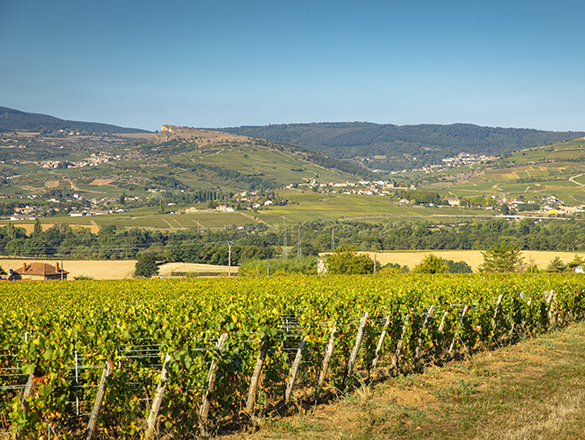
The vineyards of Bourgogne produce some great wines with a historical and international reputation. However, the region is not simply limited to its iconic appellations. In addition to its Village Premier Cru and Grand Cru AOCs, it also produces a range of wonderful Régionale and Village appellations to explore.
You will also find a full list of the Bourgogne’s Climats and lieux-dits on this page.
Check out the complete list of the 84 Bourgogne appellations.
However, your exploration has only just begun. Bourgogne wines have never before offered such high quality. Besides our range of internationally celebrated wines, try some of our lesser-known appellations where there are lots of surprises in store.
And for a fun way to find out more about the wines on offer, try out our “Which Bourgogne wine is right for me?” quiz, or check out Bourgogne Maps to take an interactive tour of the region.
Regional Appellation
VIGNOBLE DU MÂCONNAIS
31 juillet 1937
White: Chardonnay
Red and rosé: Gamay
Area under vine:
White: 59 hectares
Red: 4 hectares
Rosé: 0.1 hectares
Note: Average over three years 2016-2018
An additional geographical denomination that is part of the Régionale Mâcon appellation in the Mâconnais. According to the 2005 specifications rules, the name Mâcon-Charnay-lès-Mâcon refers to white, red, and rosé wines grown within a defined area in the village of Charnay-lès-Mâcon.

A lovely color ranging from pale to yellow gold, the white wines of Mâcon-Charnay-lès-Mâcon deliver all the fleshy opulence of southern wines. On the nose, they start with white blossom and acacia with a touch of mango. They have a forthright attack that goes on to deliver a generous smoothness.
While they are often aged in stainless steel, some time spent in oak sometimes brings buttery, creamy, fresh notes with no heaviness or ostentation, evolving into herbs and tropical fruit. This maturity in the attack is rounded out by a slightly saline finish.
Mâcon-Charnay-lès-Mâcon wines develop some remarkable qualities when aged for 5-6 years, during which they gain in complexity and acquire a delightful balance.
A rich garnet color, these reds open fairly quickly to reveal distinctly spicy aromas combining pepper and cloves, bringing body and smooth tannins in the mouth leading to a fruity chewiness of berries and orchard fruits.

White: With its sunny aromatic character and smoothness on the tongue, this wine makes a natural pairing with all kinds of goat cheeses, such as the traditional AOC Mâconnais or its neighboring Charolais for a terroir-themed aperitif. Follow with grilled Bresse chicken supremes or mixed fried fish from the Saône river. This white wine will also bring out the best in local freshwater fish dishes, such as Dombes carp with white wine, or pochouse from Verdun-sur-le-Doubs.
Serving temperatures: 10-11°C as an aperitif, 11-12°C with food
Red: With its aromatic opulence and fleshy mouth, this wine is a remarkable companion with more fibrous meat dishes such as duck ravioli or braised côte de bœuf. For wine-marinated dishes, choose a hot year such as 2018, which will help soften the acidity of the sauce in a bœuf bourguignon or a snail meurette. To finish a meal, try a local washed-rind cow’s milk cheese that’s not too old, or something drier like a Palet de Bourgogne or a Cendré de Vergy, to match the freshness of the Gamay.
Serving temperature: 14-15°C

The conjunction “lès” means “near to”, and as its name suggests, Charnay-lès-Mâcon is located close by the town of Mâcon. To the west, the old village of Charnay looks down over the valley of the Petite Grosne river, marking the southern end of the appellation.
This area has a reputation as a crossroads and that is largely thanks to Charnay, which had a key role in the past in terms of the distribution of Mâcon wines.
It was from here that winemaker and merchant Claude Brosse, honored with the title of the King’s Wine Commissioner, set off in his ox cart in 1720 to find new outlets for these wines. His audacity helped accelerate exports of Mâcon wines along routes linking the ports of Digoin and Pouilly-sur-Loire to the Seine and Paris via the Briare canal, which became operational in 1642. The vaulted cellars in the hamlet of La Massonne, the Saint-Pierre barns, and the cellars of the Abbey of Saint-Pierre-Hors-les-Murs were all used by traders during this period of intense commercial activity.

The vines of Mâcon-Charnay-lès-Mâcon grow on the tops of the long mountainous range that runs from Tournus in the north to Chaintré in the south. They enjoy a very southerly climate that is hot with around 850mm rainfall annually, and the singing cicadas offer a Mediterranean feel. In winter, fog is less frequent here than in the Saône Valley.
Between the hamlets of Levigny at 260 meters above sea level and Le Voisinet at 200 meters above sea level, the vines gently descend the slope from north to south, joining the valley of the Petite Grosne. The Jurassic ridge of Levigny is characterized by alternating layers of limestone massives and soft marl. One also finds yellow limestone specific to this area, where stones known as “cailles” appear, which shatter when they come in contact with fire. This area has the best drainage, and as a consequence is well-suited to vine growing. Closer to the river, the vines, which still face south-southwest, are spread out more irregularly on Quaternary alluvium and limestone scree from an alluvial fan.
